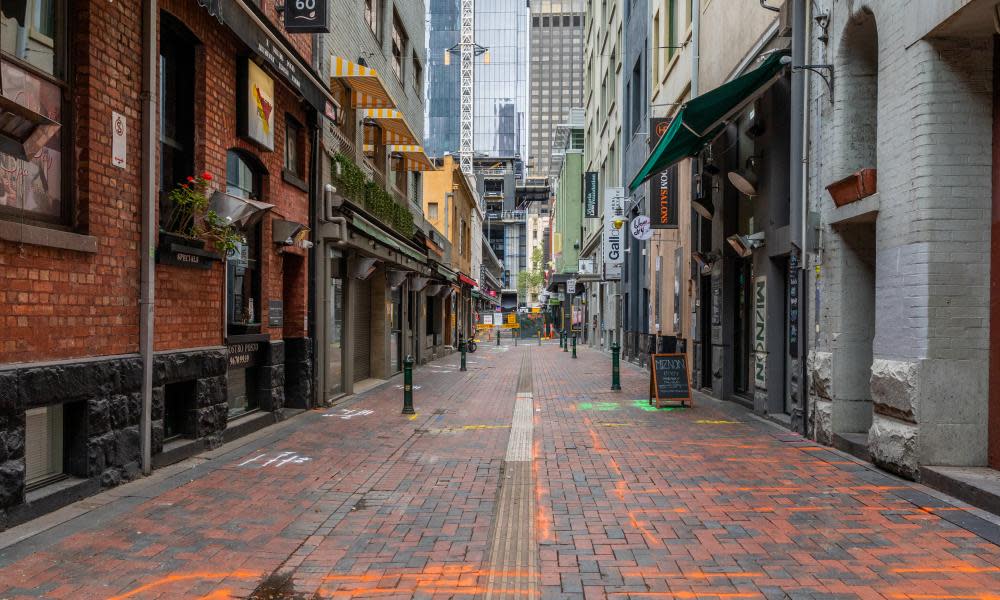Melbourne Covid curfew ends and restrictions ease, but Victoria introduces huge new fines

Melbourne’s nighttime curfew will end on Monday and coronavirus restrictions may ease faster than expected, Daniel Andrews has announced.
Victoria would now base its decisions about public health restrictions on case numbers, rather than aspirational dates, the premier said. This could mean the state would take its next step towards lifting restrictions as early as 19 October, with an aim for a “Covid-normal Christmas”, Andrews said.
On Sunday Andrews announced the curfew, which has been in place from 9pm to 5am in Melbourne, would be lifted from Monday morning. Among other changes to restrictions, he said:
Related: 'We should not pretend everybody is suffering equally': Covid hits Australia's poor the hardest
127,000 workers can return to various industries, including supermarket, food distribution, food processing, manufacturing and some solo outdoor employees, will return to work – about 30,000 more than initially planned.
Primary school students return to schools in the week beginning 12 October.
Childcare centres can open for all children, and visitors will be allowed in healthcare facilities and hospitals – one visitor per patient per day for a maximum of two hours for most patients. For those under 18, two parents or carers can visit with no time limit.
Public gatherings of people from one household, or a limit of five people from no more than two households, will be allowed. This also applies to faith-based activities and weddings held outdoors.
Hiking, fishing and other exercises that don’t involve visiting a facility will be allowed for a maximum of two hours, within 5km of home.
In conjunction with the easing of restrictions, the state would increase fines for breaching rules about gatherings to almost $5,000, Andrews said.
“I’m not only proud of the Victorian community, I am deeply grateful for the amazing work, the sacrifice, the pain that they have enjoyed and will need to endure for a bit longer in order to defeat this second wave and then open up and stay open,” Andrews said.
“We are ahead of schedule, we have made more progress than we hoped to make at this point in time. Now, that is something we can all be pleased about it but it doesn’t mean this is over.
“There are many things to be very optimistic about. We can’t just say, right, these numbers are low, it’s done. It is not, it will come back with fury. It will run wild if we just let this go, if we pretend it is over when it isn’t, we will finish up in a very different circumstance very quickly.
“If we can find it in ourselves, all of us, just to get the job done. Three more weeks and then we can take a significant step. It is not the final step but it is a significant step and it is a big step back to normal.”

The changes were announced after Victoria recorded another 16 cases, and the number of active cases fell below 400 for the first time since 14 June. The two-week rolling case average for new coronavirus cases in Melbourne has fallen to 22.1, well below the stated aim of between 30 and 50. The average is just 0.6 for regional Victoria.
Virus reproduction rates are falling about 20% every five or six days.
Victoria’s chief health officer, Brett Sutton, said he had supported ending the curfew.
“That is a very different situation to where we had been in recent weeks, certainly even different to a fortnight ago when we had 50-60-70 cases per day.”
‘The sporadic, individual community cases that we are seeing are now very small in number. Over the course of the last couple of weeks ... we are getting down to one to three community cases per day and so in reflecting on the obligations of the Victorian charter and the Public Health and Wellbeing Act and issue of proportionality, it is my view and it was the public health team’s view, that the curfew is not a proportionate measure to have in place going forward.”
Related: What Australia needs to do to avoid a third Covid wave
New South Wales on Sunday recorded no new cases of Covid-19 for the first time since 10 June.
Dr Christine Selvey from NSW Health thanked the community for their efforts in reducing case numbers, but asked people to remain vigilant and come forward for testing if they had a runny nose, scratchy throat, cough or fever.
“This is particularly important for the start of the school holidays and increased movement of people around the state,” she said.
Meanwhile, traces of Covid-19 have been detected in raw sewage across Sydney as part of new research that could provide another tool in the fight against the pandemic, NSW chief health officer Kerry Chant said.
Chant said the sewage-testing program undertaken by NSW Health and Sydney Water started in July and could show where the virus had been and provide early warning in places without known or recent cases.
A mystery infection on Friday ended a three-day run for NSW without community transmission.
The man in his 50s had not had contact with a previously confirmed case.
There are concerns his infection could reset NSW’s “border clock” with Queensland – which requires 28 days with no community transmission before the northern state will allow free movement – if authorities can’t determine how he got sick.
Queensland reported one new case on Sunday, a person in hotel quarantine.


